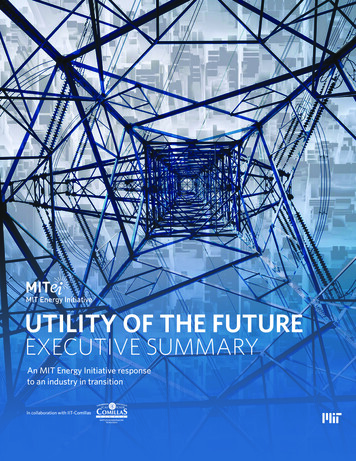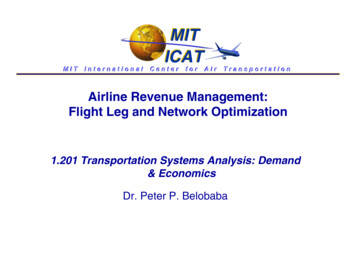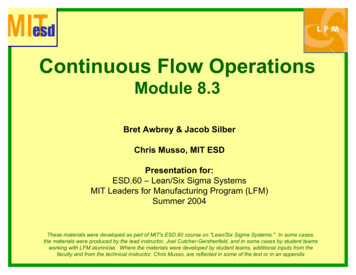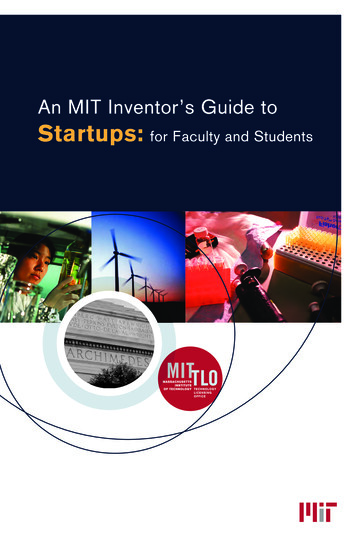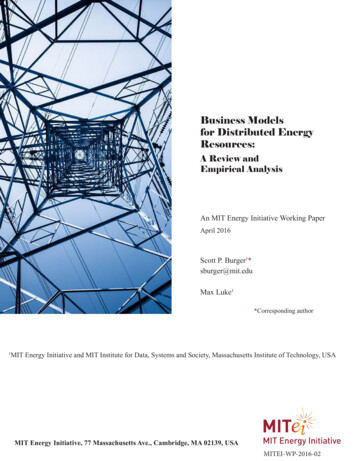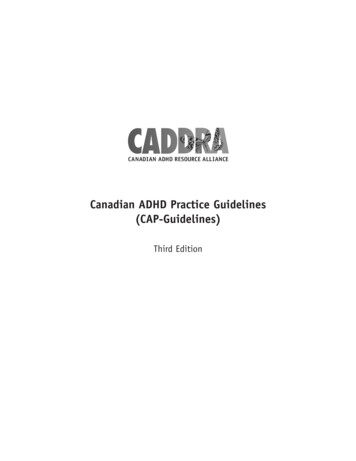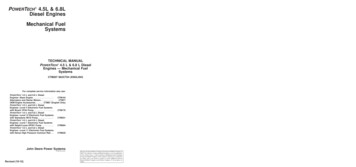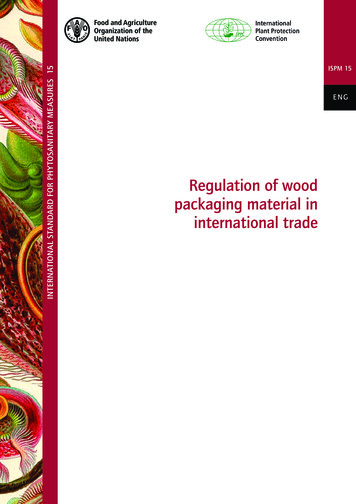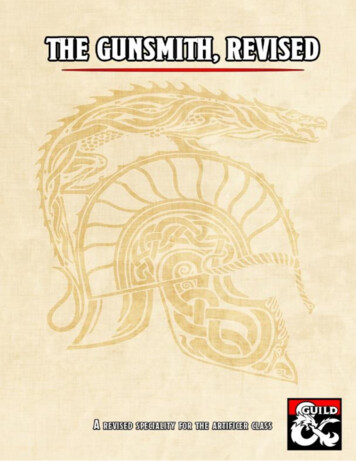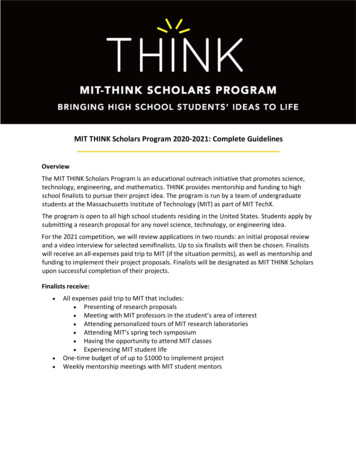
Transcription
MIT THINK Scholars Program 2020-2021: Complete GuidelinesOverviewThe MIT THINK Scholars Program is an educational outreach initiative that promotes science,technology, engineering, and mathematics. THINK provides mentorship and funding to highschool finalists to pursue their project idea. The program is run by a team of undergraduatestudents at the Massachusetts Institute of Technology (MIT) as part of MIT TechX.The program is open to all high school students residing in the United States. Students apply bysubmitting a research proposal for any novel science, technology, or engineering idea.For the 2021 competition, we will review applications in two rounds: an initial proposal reviewand a video interview for selected semifinalists. Up to six finalists will then be chosen. Finalistswill receive an all-expenses paid trip to MIT (if the situation permits), as well as mentorship andfunding to implement their project proposals. Finalists will be designated as MIT THINK Scholarsupon successful completion of their projects.Finalists receive: All expenses paid trip to MIT that includes: Presenting of research proposals Meeting with MIT professors in the student’s area of interest Attending personalized tours of MIT research laboratories Attending MIT’s spring tech symposium Having the opportunity to attend MIT classes Experiencing MIT student lifeOne-time budget of of up to 1000 to implement projectWeekly mentorship meetings with MIT student mentors
TimelineApplication DeadlineJan. 1, 2021Finalist DecisionsMid-Jan. 2021Finalists’ Trip to MITEarly Feb. 2021Expected Completion of ProjectsJune 2021Eligibility Requirements You must be a full-time high school student (i.e. attending a public, private, or homeschool) at the time of your applicationYou must be a US resident during the 2020-2021 academic year US citizenship is not required US citizens living outside the country are not eligibleOne submission per applicantOne or two students per projectApplication ProcessThe process for entering the MIT THINK Competition is as follows: Register: create an account using your email address and enter the required personalinformation(Optional) Find a partner: you can work alone or with one partnerSubmit your proposal: upload your project proposal, making sure to follow theinstructions outlined below in Proposal GuidelinesThe THINK Team will open the application portal at think.mit.edu during the fall semester.Program VisionDear Students and Teachers,The MIT THINK Scholars Program was launched in 2008 by a group of MIT undergraduates. Thecompetition’s name stems from our vision to promote Technology for Humanity guided byInnovation, Networking, and Knowledge.THINK’s vision is to make science and technology research and development accessible tomotivated high school students.
Rather than simply recognizing high school students who have completed projects, we would liketo support and encourage students who wish to implement new ideas. Accepted students willreceive seed funding and mentorship from the THINK team.Our philosophy is that, although students at the high school level may not have the experienceor resources of a professional researcher, many of them certainly have the creativity and passionto make significant contributions to science and technology. We hope to share with thesestudents the resources and connections that we have at MIT and in industry.The human aspect is where THINK differs from typical competitions. In a results-oriented world,the process is often overlooked, even though it is typically the most challenging and arduous partof a project. This is where the guidance and support of others can be immensely beneficial to anaspiring scientist or engineer. We hope to provide students with an external support networkthat will guide them in their endeavors.Over ten cohorts of MIT THINK Finalists have now participated in the program. Year after year,finalists have described the experience as transformational and profoundly rewarding. Severalalumni have gone on to attend MIT, both as undergraduates and graduate students, and somehave later served on the THINK Team.We hope THINK will be an inspirational experience that helps nurture the next generation ofyoung innovators, providing them with the support they need to turn their ideas into reality.The MIT THINK TeamProposal GuidelinesPlease read these guidelines carefully and adhere strictly to the format given here. Make sureto clearly address each required component in your PDF submission.Failure to follow this format may result in an invalid application.Teams should work together to write a single project proposal.Formatting, Lengths, and Citations: Use 12-point Times New Roman or Arial fontDouble spaced (1.5 not allowed) with 1 inch marginsPage limit: 10 pages. (References will not count against the 10 page limit.)Please cite all references and include a list of references at the end of the projectproposal.All images and diagrams that you did not create yourself should also be cited.Include any tables and figures in the body of the text.
The project proposal should be divided into the following sections for readability: A title and abstract,A first section explaining your project’s motivation and approach,A second section addressing project logistics and organization,And a section on personal interest (as detailed further below).Following the suggested format will help ensure that you include all required information and aidthe THINK Team in the judging process.1. Project Title Name: your name(s), schoolMentor (optional): name, email address, affiliation (university, school, company, etc.)2. AbstractWrite an engaging, thorough, and concise abstract of up to 250 words summarizing your project.In paragraph form, please describe the following aspects of your project:Motivation: What is the problem you are trying to solve? Why is this an importantproblem to address? Goals: What are the desired outcomes of your project? Approach: How do you plan to implement your project proposal? 3. Idea 4. Plan Problem: Clearly identify the need or problem you are trying to solve. Explain any background information needed to understand the context andmotivation of your project. Cite existing scientific literature to contextualize your project’s contribution. Include relevant scientific theory.Current Work: Identify current state-of-the-art approaches or solutions. Explain why they are insufficient.Solution: Describe your proposed solution. Describe how it will address the need or problem. Compare your idea to existing solutions. Explain how your solution improves upon the current technology.Approach: Walk through the steps to implement your project proposal. Convince us that your project is technically feasible
Use diagrams and show calculations as necessary.Resources: Specify the resources (i.e. materials, mentorship, and funding) you will need toobtain during the process of implementing your project. How will you acquire these resources? If applicable, are you planning on working with a local mentor in addition tomentorship from the THINK Team? Goals: Establish milestones and completion criteria for your project. How will you test and evaluate your project? What are its performance specifications (if applicable)? If you are working with a partner: Discuss how you plan to divide the work and responsibilities. Explain how you will facilitate collaboration. Risks: Identify at least three issues you might encounter during implementation. What specific strategies or solutions could you use to mitigate them? Timeline: Identify key deliverables and deadlines. How will you document the implementation process between these milestones? Current Progress and Need for Funding: Describe any previous work you have done on this topic. What have you achieved so far, and what remains to be done? How will funding from the MIT THINK Scholars Program allow you to achieve yourproposed goals? Project Budget: Provide a detailed budget in table form. List each item, amount to be purchased, cost, and links to suppliers if you can findthem. If you are unable to find exact costs or have materials with variable costsdepending on project implementation, estimate to the best of your ability. Please ensure that your total costs do not exceed the program budget of 1000per finalist.5. Personal Interest: Tell us about your academic background as well as your personal interest in thisproject. We want to know where you are coming from, what previous researchexperience (if any) you have, and why you are interested in your area of research.Qualifications: Describe the skills you currently have as well as the skills you will need tolearn to complete this project.6. References Cite all consulted sources using the APA format.
Include both in-text citations and a References page at the end of the project proposal. The References section will not count against the 10 page limit.Important note: make sure to address every bullet point in this outline.In particular, you must address how your project would benefit from funding and mentorship fromMIT THINK. Proposals which do not explain what the applicant(s) will gain from the program will notbe selected to advance in the competition.Judging CriteriaA panel of MIT undergraduates (the MIT THINK Team) will review applications based on thefollowing criteria: Impact: How relevant, important, or interesting is the identified problem?Innovation: How novel or creative is the proposed solution? How is it contextualized within existing work? How does it improve upon existing solutions?Clarity: Are the goals, methods, and timeline clearly defined? Can the results be clearly and reliably evaluated? Is the discussion of the problem, existing technologies, and proposed solutionsaccurate and complete?Feasibility: Can the stated goals be completed within the cost and resource constraints? Can the project be implemented within the one semester time frame?Benefit: How much will this project benefit from THINK funding and mentorship?Finalists’ TripUp to six projects will be selected as MIT THINK finalists; these students will participate in theMIT THINK Scholars Program. Finalists will be invited to MIT for the Finalists’ Trip. During the trip,finalists will meet the THINK Team, present their project proposals, meet with MIT professorswho share their research interests, and tour MIT laboratories. All finalists will be given funding(up to 1000) and mentorship to complete their projects. Upon successful project completionand submission of a final report, finalists will be honored as MIT THINK Scholars for the 2021competition.Project Implementation and Mentorship (for Finalists)
While you implement your project, we will maintain an active relationship with you. We willprovide you with funding, mentorship, and networking opportunities with sponsors, MITstudents, faculty, and alumni. In return, we expect that you document the whole process in theform of progress reports, photos, and videos. Documentation should show the successfulcompletion of milestones and goals, and any difficulties or challenges encountered along theway. Your project experience will be shared with our sponsors and the MIT community. Inaddition, we will hold regular phone or web conferences to check on your progress, provideadvice, and teach you some useful skills. By the end of the spring semester, you will be expectedto submit a detailed final report documenting your project from start to finish.FAQsWhen is the application due?11:59pm ET on Jan 1, 2021.Can my proposal be longer than 10 pages?Unfortunately, no. Additional pages can only contain references.I am in a team of two. How do we create an account for two people?Create separate accounts, fill in the application information individually, and submit the sameproposal at the end.I am an International Student. Can I still apply?Unfortunately, we currently only accept applications from high school students living in theU.S.Who judges these applications?The THINK Team.How will I know if I won?Semifinalists will receive an email invitation for an interview mid-January. The final results(semifinalists and finalists) will be posted on our website later that month.Where can I send my other questions?Please send all questions to think@mit.edu.
EXAMPLE PROJECT PROPOSALFrom Pixel to Paragraph: A Deep Artwork Paragraph GeneratorAudrey Cui, Monta Vista High SchoolABSTRACTArt influences society by shaping our perspective and sense of self. Since not all pieces ofart are extensively captioned, I wonder: would it be possible for computers to understand and thendescribe artwork? Automated artwork analysis will make art more accessible to the visuallyimpaired and facilitate semantic searches for artwork conveying specific themes, enabling a wideraudience to enjoy art and experience what artists communicate through their artwork. The goal ofmy project is to develop an artificial neural network system that interprets input artwork andgenerates a paragraph describing objects and low level features present in the artwork, as well asideas and emotions the artwork conveys. I will develop a visual-semantic embedding space thatlearns the relationship between artwork image features and art analysis paragraph sentences. Theembedding module retrieves the most relevant sentences to the input artwork features. Thesesentences are fed into a generative adversarial network with a novel sentiment filter to generatethe final art analysis paragraph, whose relevance to the input artwork is evaluated with a SPICEscore. By expanding upon a human’s interpretation of artwork with new and sometimes surprisinginsight, my project makes progress towards developing a creative AI.MOTIVATION AND APPROACHNot all art pieces are extensively captioned — therefore, my project of generating artanalysis paragraphs based on input artwork will make art more accessible to the visually impairedand also facilitate semantic searches for artwork conveying specific themes. Training machines tounderstand artwork will also advance progress towards innovating creative AI.
The objective of my project, generating paragraphs based on images, is similar to that of(Kiros, 2015). Kiros generated romantic stories from images by training an RNN decoder on acorpus of romance novels to decode the closest Microsoft COCO captions retrieved by anembedding module (Lin et al., 2015; Kiros et al., 2014a). In an embedding module, the input isencoded into a vector representation that can then be mapped to the most similar vectorrepresentation of the output modality, which is subsequently decoded into the final output. Thisapproach is effective for image captioning in general, but is less effective for describing artworkand generating long sentences. Themes in artwork are abstract and usually implicitly conveyedthrough its stylistic features such as texture and color palette in addition to the objects present.Furthermore, such objects often have exaggerated proportions or are abstractly rendered, so acaptioning model trained on real life photographs (i.e Microsoft COCO) most likely would not beable to describe artwork accurately. In addition, using an RNN decoder to generate paragraphs issubject to exposure bias — each word is generated based on only previously generated words, soone error may render the rest of the sentence nonsensical (Yu et al., 2017).Generative adversarial networks (GAN) have shown great promise in text generation. AGAN consists of a generator, which generates data that is evaluated by a discriminator. Thediscriminator learns to differentiate between the generated data and the ground truth. Duringadversarial training, the discriminator improves at telling apart generated data from real data,forcing the generator to gradually generate more realistic data (Goodfellow et al., 2014; Yu et al.,2017). Since it is an iterative process rather than one-and-done as with a single decoder, a GANshould generate more comprehensible paragraphs than a decoder. LeakGAN introduced ahierarchical structure to the generator by splitting it into a manager and a worker module (Guo etal., 2017). The discriminator creates a features map that is “leaked” to the manager, which forms
a goal embedding vector including syntactic and semantic information to guide the worker ingenerating the final paragraphs. This modification enables the generator to better learn thesyntactic and semantic structure of sentences, making long text generation more effective.I will develop a visual-semantic embedding (VSE) module trained on a corpus of artworkimages and their corresponding analysis paragraphs, a sentiment extractor CNN, and a GAN togenerate the final paragraph analyzing input artwork. The paragraph will contain sentences similarto “the coarse brushstrokes convey the strained relationship between man and nature.” LikeLeakGAN, my GAN consists of a discriminator that leaks information to the generator, whichincludes a manager and worker, so that it can effectively generate relatively long text. To narrowthe semantic gap between the generated paragraphs and input artwork, my GAN will generateparagraphs based on sentiments conveyed by the artwork via a novel sentiment filter that I propose.My solution is feasible because I have already implemented a “prototype” of the VSE and the codefor LeakGAN, which I will build upon, is open source.PROJECT LOGISTICS AND ORGANIZATIONI will develop an artificial neural network consisting of a VSE module, sentiment extractor,and GAN to generate a paragraph analyzing an input piece of artwork. To generate a paragraphfrom end to end, the artwork image object features are first computed as the output feature mapfrom the penultimate layer of VGG19, a pretrained image recognition CNN (Simonyan andZisserman, 2015). Image sentiment features are computed by another CNN that I will train. TheVSE module retrieves the top 5 nearest pre-encoded sentence vectors to the encoded image objectfeatures. The mean of the nearest sentence vectors is fed into a GAN, which also conditions on theartwork sentiment to generate the final paragraph.
To build my datasets for training models, 3,180 images of artwork and their correspondinganalysis paragraphs are scraped from theartstory.com using the library BeautifulSoup(Zurakhinsky, 2018; Richardson, 2018). A text encoder model [1] is first trained on a corpus ofthe scraped paragraphs and learns the features of the paragraphs in order to encode text as its skipthought vector representation (Kiros et al., 2014b). Since skip thought vectors are biased for length,vocabulary, and syntax, the final generated paragraphs should sound like the art analysisparagraphs the encoder was trained on.The embedding space [2] is a common vector space in which the encoded image objectfeatures from VGG19 and skip thought vectors can be projected upon for learning textualrepresentations of input images. The image object features [3] are encoded with a pretrained image
encoder from (Kiros et al., 2014a). The art analysis paragraphs are first summarized as its 3 mostimportant sentences with Text Teaser to reduce computational load and then encoded by mytrained encoder model [1] (Balbin, 2014). The dataset is split into 70% train, 15% validation, and15% test for developing the embedding module.Parallel to this, I will train an image sentiment CNN [4] on OASIS, a dataset of 900 imagesannotated with valence and arousal (VA) ratings (which is a number between 1-9), in order topredict the VA of input artwork (Kurdi et al., 2017; Hu and Flaxman, 2018). VA is a model widelyused in psychology that can express any emotion in the two parameters of valence (pleasantness)and arousal. Since low level features such as color palette and composition influence sentiment,image features are represented by the output of an intermediate layer of VGG19, which capturessuch low level features (Gatys et al., 2015).The GAN for paragraph generation will be based on a LeakGAN framework, which is stateof the art for long text generation (Guo et al., 2017). Like LeakGAN, the discriminator [5] in myGAN leaks a feature map [6] to a manager module [7] that creates goal vector [8]. The goal vector,which includes sentence structure and semantics, guides the words generated by a worker module[9] via a dot product of the worker’s output and the goal vector. I propose that following thesoftmax [10], which creates a probability distribution for possible next words, a novel sentimentfilter [11] selects for words close in sentiment to the artwork. To do this, my corpus of words fromart analysis paragraphs is embedded with a dataset of 13,915 English lemmas annotated for VA(Warriner et al., 2013). The sentiment filter modifies the probability distribution by multiplyingeach word’s probability with their cosine distance from the lemma closest to the input artwork’sVA. The distribution is normalized so that each probability is between 0 and 1 and the distribution
sums to 1. This modification of LeakGAN enables the generated paragraphs to take intoconsideration sentiment, which is a key aspect of art analysis.Since my project is purely computational, a laptop and desktop are the only physicalresources I need, both of which I already have. I would love to be mentored by the THINK team,receive advice from MIT professors, and possibly be granted access to larger text/image datasetsby MIT.I have already implemented a “prototype” version from end to end — an encoder encodesimage object features, which the embedding space uses to retrieve encoded sentences. A decoderconditions on those sentences to generate the final paragraph, which were nonsensical (“CubismeRotterdam Rotterdam college colonial-inspired [.]”). Going forward, here are my milestones:1. Implement LeakGAN w/o the sentiment filter to generate comprehensibleparagraphs. While a decoder is subject to exposure bias, I believe paragraphs generatedby a GAN would be more comprehensible because the output is refined iteratively. Toevaluate how close semantically the generated paragraphs are to ground truth paragraphs,I will calculate a Semantic Propositional Image Caption Evaluation (SPICE) score(Anderson et al., 2016). For reference, the SPICE of fairly recent photograph captioningmodels are 0.05-0.06, while randomly generated words are 0.008. I hope to achieve aSPICE of 0.03, since artwork is more subject to interpretation than photographs.2. Train an image sentiment CNN. To evaluate this CNN, I will calculate the mean squareerror (MSE) between the ground truth and the predicted values for valence and for arousal(Hu and Flaxman, 2018). MSE should be less than 2 for both valence and arousal.3. Implement sentiment filter and generate paragraphs conveying sentiment. Generatedparagraphs will be evaluated with SPICE. Since I do not want to sacrifice relevancy for
sentiment, the SPICE of a sentimental paragraph should not be more than 10% less thanthe SPICE for a non-sentimental paragraph generated from the same image.The following addresses possible issues and solutions:1. If my GAN does not generate comprehensible paragraphs, I will train it on a larger datasetincluding art history ebooks in addition to my art analysis corpus, decrease the learn rate,and increase the number of epochs during adversarial training.2. I am not entirely sure whether my sentiment filter enables the generated paragraphs toconvey artwork sentiment while retaining meaning. If it does not meet my performancespecifications, I will develop a method to incorporate sentiment in either the leaked featuresor the reward signal given to the generator from the discriminator.3. If none of the approaches for incorporating sentiment in the GAN mentioned abovesuccessfully generates paragraphs conveying artwork sentiment, I will develop anembedding module that learns the relationship between the analysis paragraphs and bothimage object AND sentiment features. While the retrieved sentences should conveyinformation about artwork sentiment, my training corpus is relatively small so I believethat incorporating sentiment in the GAN would more likely be successful.Timeline:1. 2/24/18: Implement LeakGAN without the proposed sentiment filler. The generatedparagraphs and their SPICE scores will be documented.2. 3/10/18: Train an image sentiment CNN. MSE and results for sample inputs will bedocumented.3. 3/24/18: Embed art analysis corpus with English lemmas. The top 10 words closest in VAto and the VA of sample words from the art analysis corpus will be documented.
4. 4/14/18: Implement my proposed method for the sentiment filter to adjust the probabilitydistribution for the next generated word. Samples of probability distributions before andafter the sentiment filter will be documented.4.4/21/18: Generate paragraphs, which will be documented, via the GAN with the sentimentfilter.5.5/26/18: Buffer time for incorporating sentiment in generated paragraphs if my proposedapproaches are ineffective. Otherwise, I will adjust the embedding module and the GAN toimprove the accuracy, comprehensibility, and SPICE of generated paragraphs. My final code willbe uploaded to Github.Current Progress:As stated above, I have already implemented the VSE that relates encoded artwork featuresto sentences in analysis paragraphs. Below is a sample of the nearest sentences retrieved by theembedding space when inputted my own artwork.
For example, my piece “Hyphenated American” above expresses my relationship with myChinese American identity. Although the highest ranking sentence (“As Michele [.] do it?’”)questions society’s expectations for black women, it appropriately captures the theme of identitypresent in my artwork, showing that the VSE is fairly successful. The retrieved sentences may notdescribe the input artwork perfectly, but some of them capture the overall meaning of the artworkto some extent.
My piece “The Explorer and Her Cat” above is about exploration igniting imagination.Interestingly, the sentence “Corot depits [.] pity her” comes from a painting with a compositionsimilar to mine and suggests a new meaning for my artwork — the explorer figure looks towardsthe hand as a divine figure for mercy. This sentence does not describe the intended themes in myartwork, but instead provides new insight that is reasonable in the context of my artwork.Funding will go to purchasing a GPU for training models on larger data corpuses faster.ItemAmount CostGeForceRTX2080 1graphics cardLink 799 /rtx-2080/PERSONAL INTERESTI once saw computer science, which abides by the unbending laws of logic, and art, whichtranscends the boundary dividing reality and imagination, as two separate universes. Thisdichotomous view of my two interests was shattered when I learned about neural image styletransfers that could transform my photos into paintings. The idea that rigid math could generateart and possibly even understand art blew my mind. In the future, I want to research artificial
intelligence and neurobiology in order to apply the intricacies of our cerebral processing systemtowards optimizing computer vision and NLP and to ultimately innovate a truly creative AI.To design my approach for generating art analysis paragraphs, I read through numerouspapers to gain a good understanding of methods in computer vision and natural languageprocessing. I have already implemented the VSE, a key part of my project. During the process, Ibecame more familiar with how machine learning models are implemented and with using librariessuch as nltk and keras (Bird et al., 2009; Chollet, 2018). Currently, I understand conceptually howa GAN works, but I will need to learn its implementation details for modifying LeakGAN in orderto generate paragraphs conveying sentiment.ReferencesAnderson, P., Fernando, B., Johnson, M., Gould, S. (2016). SPICE: Semantic Propositional ImageCaption Evaluation. Computer Vision – ECCV 2016 Lecture Notes in Computer Science, DOI:10.1007/978-3-319-46454-1 24Balbin, J. (2014). TextTeaser. Github repository, https://github.com/MojoJolo/textteaser.Bird, S., Loper, E., Klein, E. (2009). Natural Language Processing with Python. O’Reilly Media Inc.Chollet, F. (2018). Keras applications. Github repository, tys, L. A., Ecker, A. S., Bethge, M. (2015). A Neural Algorithm of Artistic Style. Journal of Vision,16(2). DOI: 10.1167/16.12.326Goodfellow, I., Pouget-Abadie, J., Mirza, M., Xu, B., Warde-Farley, D., Ozair, S., Courville, A.,Benglo, Yoshua. (2014). Generative Adversarial Nets. Advances in Neural InformationProcessing Systems 27 (NIPS 2014).
Guo, J., Lu, S., Can, H., Zhang, W., Yu, Y., Wang, J. (2017). Long Text Generation via AdversarialTraining with Leaked Information, arXiv preprint arXiv:1709.08624Hu, A., Flaxman, S. (2018). Multimodal Sentiment Analysis To Explore the Structure of Emotions.arXiv preprint arXiv:1805.10205.Kahlo, F. (1940). Self Portrait with Thorn Necklace and Hummingbird [oil on canvas]. Harry RansomCenter, University of Texas Austin, Austin. The Art Story.Kim, H., Kim, Y., Kim, S., Lee, I. (2017). Building Emotional Machines: Recognizing Image Emotionsthrough Deep Neural Networks. arXiv preprint arXiv:1705.07543v2Kiros, J. R. (2015). Neural-storyteller. Github repository, os, J. R., Salakhutdinov, R., Zemel, R. S. (2014a). Unifying Visual-Semantic Embeddings withMultimodal Neural Language Models. arXiv preprint arXiv:1411.2539.Kiros, J. R., Zhu, Y., Salakhutdinov, R., Zemel, R. S., Torralba, A., Urtasun, R., Fidler, S. (2014b). SkipThought Vectors. arXiv preprint arXiv:1506.06726.Kurdi, B., Lozano, S., Banaji, M. (2017). Introducing the Open Affective Standardized Image Set(OASIS). Beha
The MIT THINK Scholars Program was launched in 2008 by a group of MIT undergraduates. The competition’s name stems from our vision to promote Technology for Humanity guided by Innovation, Networking, and Knowledge. THINK’s vision is to make science and technology research and
